THE ARGENTINE PAVILION IN THE VENICE BIENNALE
Ojalá se derrumben las puertas (Hopefully the Doors Will Fall Down) by artist Luciana Lamothe, curated by Sofía Dourron, is the installation presented by the Argentine Pavilion at the 60th International Art Exhibition of the Venice Biennale 2024.
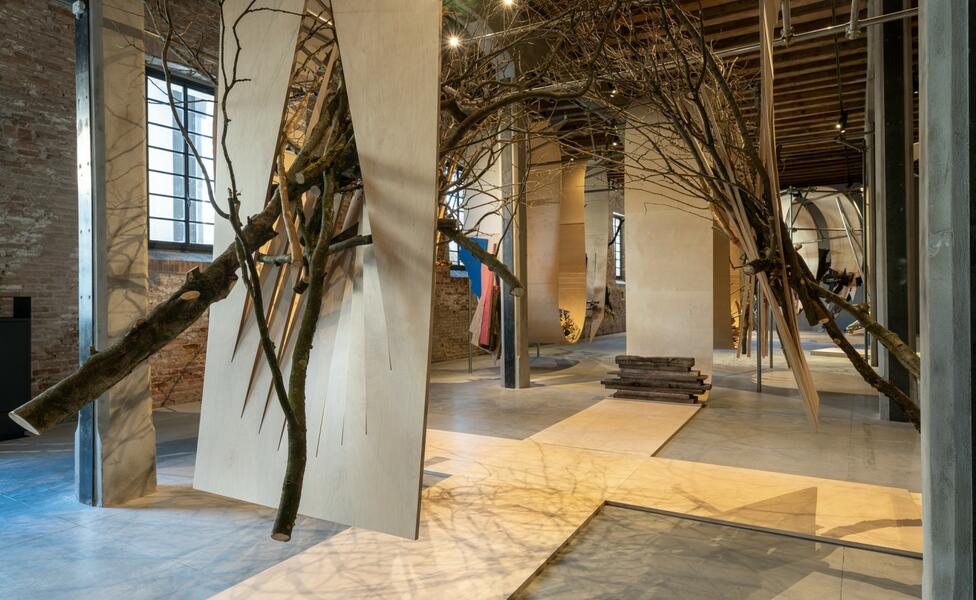
Conceived around the architecture of the Argentine Pavilion, the work consists of four structures made up of iron scaffolding, curved phenolic strips and a series of sculptures made from scraps of discarded, burned, perforated and cut wood, as well as branches, trunks, fragments of pipes and metal knots that connect them. It states the need to overcome the hegemonic ways of inhabiting the planet, which have produced a present plagued by climatic, migratory, economic, social and territorial crises.
In tune with the curatorial statement “foreigners everywhere” formulated by the curator of the Biennale Arte 2024, Adriano Pedrosa, the artist proposes material environments in which difference is not a weakness, but the greatest of strengths. Those who circulate through the work are sensitive to experience other ways of inhabiting, queer, solidary and symbiotic forms. Ojalá se derrumben las puertas establishes an affective and sensual bond with the materials, to overflow the frontiers that separate culture and nature, the human and the non-human.
-
Pabellón de Argentina. Ojalá se derrumben las puertas. 60th International Art Exhibition - La Biennale di Venezia. Foto: Andrea Avezzù. Cortesía: La Bienal de Venecia.
-
Pabellón de Argentina. Ojalá se derrumben las puertas. 60th International Art Exhibition - La Biennale di Venezia. Foto: Andrea Avezzù. Cortesía: La Bienal de Venecia.
-
Pabellón de Argentina. Ojalá se derrumben las puertas. 60th International Art Exhibition - La Biennale di Venezia. Foto: Andrea Avezzù. Cortesía: La Bienal de Venecia.
-
Pabellón de Argentina. Ojalá se derrumben las puertas. 60th International Art Exhibition - La Biennale di Venezia. Foto: Andrea Avezzù. Cortesía: La Bienal de Venecia.
Lamothe's meticulous manipulation of the material world combines elements and sequences of reactions, weights and counterweights, invokes more than human alliances and a spatial alchemy that generate new formal, aesthetic and affective possibilities for the bodies and objects they contain. It creates undisciplined spaces that oppose not only the constructive forms of modernity, but also rebel against what Malcom Ferdinand calls a “colonial way of inhabiting,” whose violence subject territories and human and non-human bodies to a system of extractivist exploitation. Each of the sculptures functions as an enveloping space that suggests other ways of conceiving our relationship with the material world around us. They contain, at the same time, forms of care and violence that are manifested in the slashes, cuts, assemblages and twists necessary for the work to maintain its form: a series of wounds and sutures that acknowledge the weight of centuries of social, spatial and material conditioning exerted on human and non-human bodies.
Argentina was the first Latin American country to take part in the International Art Exhibition La Biennale Di Venezia, in 1901. Since 2011 it has had a national pavilion of more than 500 square meters and its uninterrupted presence constitutes a valuable State policy that is consolidated through each shipment and ensures Argentina's cultural dissemination at the highest international level.
-
Pabellón de Argentina. Ojalá se derrumben las puertas. 60th International Art Exhibition - La Biennale di Venezia. Foto: Andrea Avezzù. Cortesía: La Bienal de Venecia.
-
Pabellón de Argentina. Ojalá se derrumben las puertas. 60th International Art Exhibition - La Biennale di Venezia. Foto: Andrea Avezzù. Cortesía: La Bienal de Venecia.
-
Pabellón de Argentina. Ojalá se derrumben las puertas. 60th International Art Exhibition - La Biennale di Venezia. Foto: Andrea Avezzù. Cortesía: La Bienal de Venecia.
-
Pabellón de Argentina. Ojalá se derrumben las puertas. 60th International Art Exhibition - La Biennale di Venezia. Foto: Andrea Avezzù. Cortesía: La Bienal de Venecia.
In addition to the exhibition in the National Pavilion, Argentina has a strong participation thanks to Adriano Pedrosa's curatorial proposal, which includes works by numerous artists born and based in Argentina.
This year, the duo Chiachio & Giannone, invited by the main sponsor of the event to exhibit two textile works, are also part of the official shipment. In addition, works by 15 Argentine artists born or based in the country are part of the exhibition curated by Pedrosa. They are Claudia Alarcon & Silät from the Wichí community La Puntana, the queer La Chola Poblete from Mendoza, Mariana Telleria from Santa Fe, Americanist painter Juana Elena Diz, and works by deceased artists Libero Badii, Elda Cerrato, Victor Cunsolo, Juan Del Prete, Raquel Forner, Maria Martorell, Emilio Pettoruti, Lidy Prati, Kazuya Sakai, Clorindo Testa and Bibi Zogbe.
May interest you
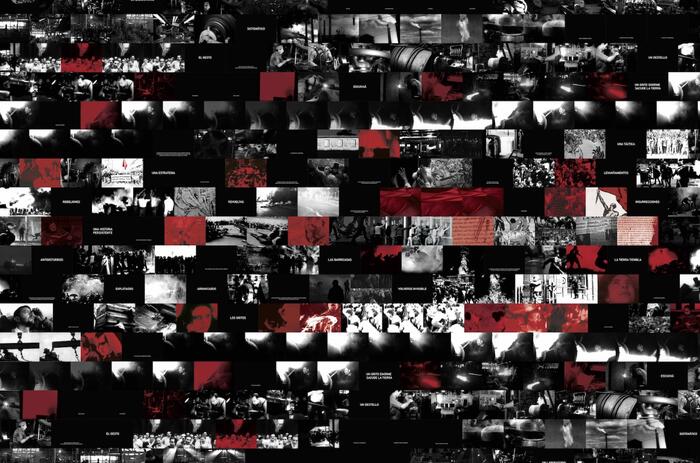
The exhibition at Rolf Art REVUELTAS by Gabriela Golder - one of Argentina's most internationally recognized audiovisual artists - presents video works in dialogue with the historic lithographic works of master printmaker Guillermo Facio Hebequer.
GABRIELA GOLDER: REVISITING THE WORKS OF FACIO HEBEQUER

The exhibition at Rolf Art REVUELTAS by Gabriela Golder - one of Argentina's most internationally recognized audiovisual artists - presents video works in dialogue with the historic lithographic works of master printmaker Guillermo Facio Hebequer.
GABRIELA GOLDER: REVISITING THE WORKS OF FACIO HEBEQUER
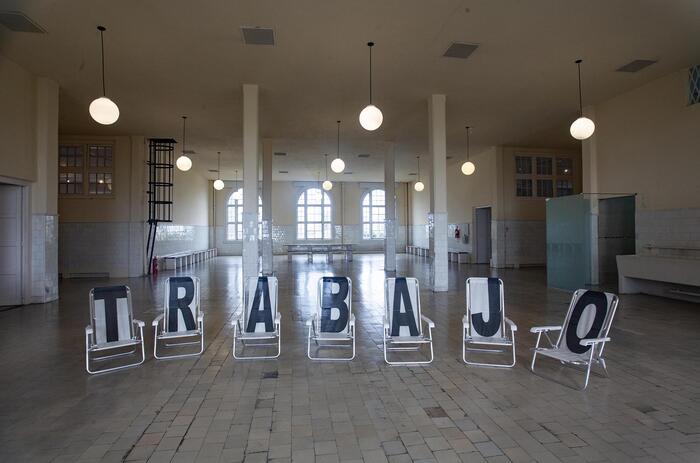
The group exhibition Los gestos del trabajo (The Gestures of Work), curated by Clarisa Appendino and Benedetta Casini, at MUNTREF Centro de Arte Contemporáneo presents works that explore the relationship between bodies, technology and work.
THE GESTURES OF WORK
The group exhibition Los gestos del trabajo (The Gestures of Work), curated by Clarisa Appendino and Benedetta Casini, at MUNTREF Centro de Arte Contemporáneo presents works that explore the relationship between bodies, technology and work.
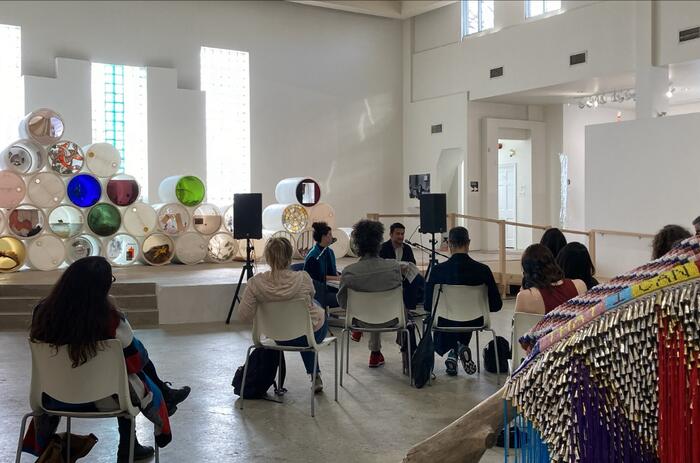
The curatorial team of the Toronto Biennial of Art (the Biennial/TBA) and its curatorial team of Dominique Fontaine and Miguel A. López announced the title, full artist list and venues for its third edition.
TORONTO BIENNIAL OF ART: PRECARIOUS JOYS
The curatorial team of the Toronto Biennial of Art (the Biennial/TBA) and its curatorial team of Dominique Fontaine and Miguel A. López announced the title, full artist list and venues for its third edition.

Patricio Reig (San Juan, Argentina, 1952) exhibits at the Centre Cultural La Mercè in Girona Anatomía de la mirada, a proposal that deals with the dissection of the act of looking and its individual and subjective approach.
PATRICIO REIG AND THE ANATOMY OF THE GAZE
Patricio Reig (San Juan, Argentina, 1952) exhibits at the Centre Cultural La Mercè in Girona Anatomía de la mirada, a proposal that deals with the dissection of the act of looking and its individual and subjective approach.
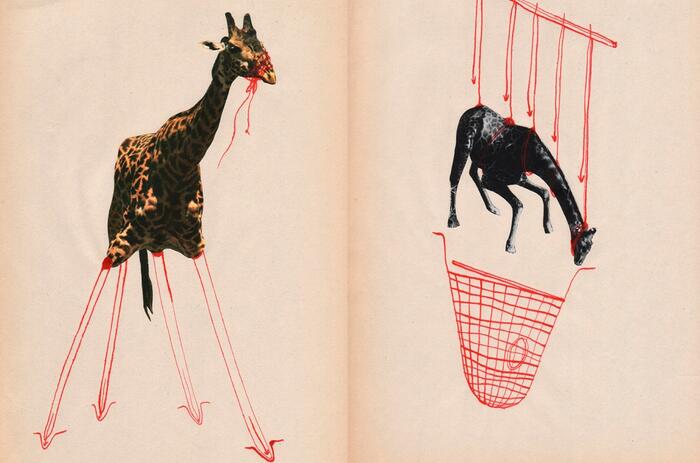
The heart of a giraffe in captivity is twelve kilos lighter tells the story of Lenka the giraffe, drawing on the history of Czechoslovakia’s acquisition of animals from the Global South. Interpreted through contemporary ecological and decolonial perspectives, Eva Kotátková’s project of the Czech and Slovak Republic Pavilion at the Venice Biennale builds a space for imagining a different way of relating to nature.
THE VENICE BIENNALE: CZECH AND SLOVAK REPUBLIC PAVILION
The heart of a giraffe in captivity is twelve kilos lighter tells the story of Lenka the giraffe, drawing on the history of Czechoslovakia’s acquisition of animals from the Global South. Interpreted through contemporary ecological and decolonial perspectives, Eva Kotátková’s project of the Czech and Slovak Republic Pavilion at the Venice Biennale builds a space for imagining a different way of relating to nature.

The Japan Foundation, the commissioner of the Japan Pavilion presents Compose, a solo exhibition created by Yuko Mohri and curated by Sook-Kyung Lee at the 60th International Venice Biennale.
COMPOSE: JAPAN PAVILION AT THE VENICE BIENNALE
The Japan Foundation, the commissioner of the Japan Pavilion presents Compose, a solo exhibition created by Yuko Mohri and curated by Sook-Kyung Lee at the 60th International Venice Biennale.

Commissioned by Facundo de Almeida and curated by Elisa Valerio, the national pavilion of Uruguay presents the work of Eduardo Cardozo with the project Latent.
THE PAVILION OF URUGUAY AT THE 60TH VENICE BIENNALE
Commissioned by Facundo de Almeida and curated by Elisa Valerio, the national pavilion of Uruguay presents the work of Eduardo Cardozo with the project Latent.

For the 60th Venice Biennale, the Republic of Armenia presents Echo, a multi-dimensional multi-media installation project by Paris-based Armenian artist Nina Khemchyan.
“ECHO” BY NINCA KHEMCHYAN: ARMENIAN PAVILION IN THE VENICE BIENNALE
For the 60th Venice Biennale, the Republic of Armenia presents Echo, a multi-dimensional multi-media installation project by Paris-based Armenian artist Nina Khemchyan.
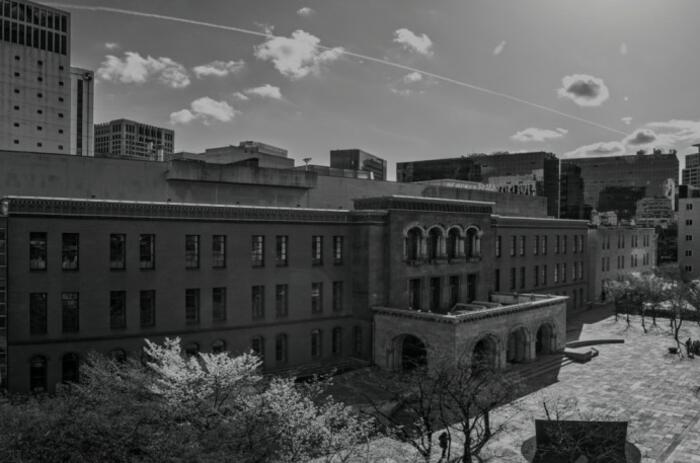
The Seoul Museum of Art is announcing an open call for the position of artistic director of the 13th Seoul Mediacity Biennale. Deadline to apply: July 28th, 2024.
13th SEOUL MEDIACITY BIENNALE CALLS FOR ARTISTIC DIRECTOR
The Seoul Museum of Art is announcing an open call for the position of artistic director of the 13th Seoul Mediacity Biennale. Deadline to apply: July 28th, 2024.
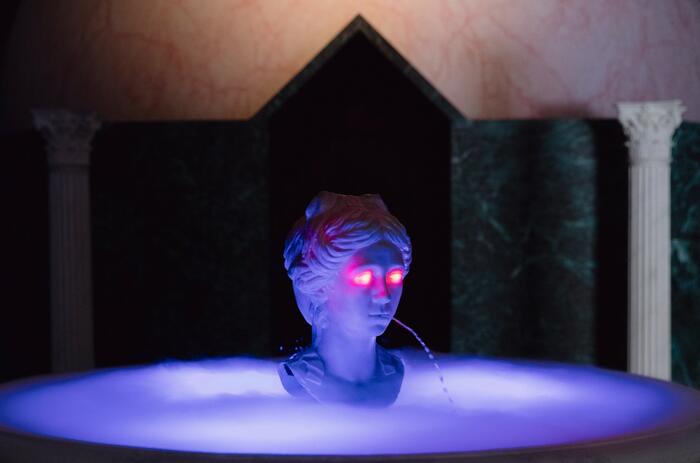
The Venice Bienanale’s Swiss Pavilion presents Super Superior Civilizations: an exhibition with the sixth and seventh chapters of Guerreiro do Divino Amor’s monumental “Superfictional World Atlas” saga: The Miracle of Helvetia and Roma Talismano. Curated by: Andrea Bellini.
THE SWISS PAVILION’S VENICE BIENNALE EXHIBITION BY GUERREIRO DO DIVINO AMOR
The Venice Bienanale’s Swiss Pavilion presents Super Superior Civilizations: an exhibition with the sixth and seventh chapters of Guerreiro do Divino Amor’s monumental “Superfictional World Atlas” saga: The Miracle of Helvetia and Roma Talismano. Curated by: Andrea Bellini.
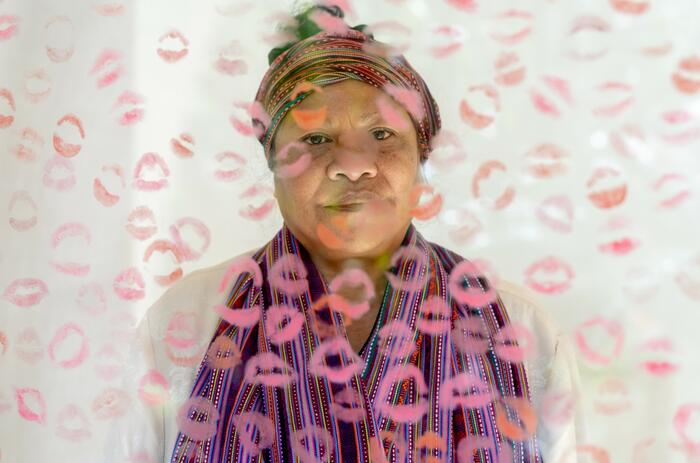
Maria Madeira is the artist representing Timor-Leste at the 60th International Venice Biennale. Timor-Leste’s inaugural pavilion coincides with the country’s 25th anniversary of independence. Commissioned by the Ministry of Youth, Sports, Arts and Culture, Democratic Republic of Timor-Leste and curated by Professor Natalie King OAM.
KISS AND DON’T TELL: TIMOR-LESTE IN THE VENICE BIENNALE
Maria Madeira is the artist representing Timor-Leste at the 60th International Venice Biennale. Timor-Leste’s inaugural pavilion coincides with the country’s 25th anniversary of independence. Commissioned by the Ministry of Youth, Sports, Arts and Culture, Democratic Republic of Timor-Leste and curated by Professor Natalie King OAM.
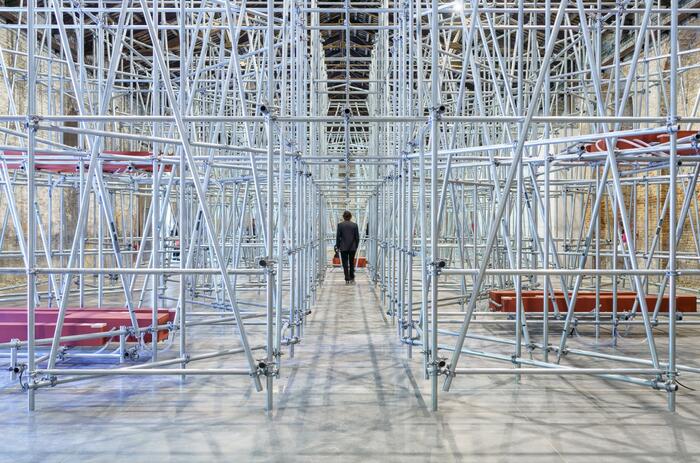
Due qui / To Hear is the project for the Italian Pavilion at the 60th Venice Biennale Curated by Luca Cerizza (with the assistance of Francesca Verga), it presents work that Massimo Bartolini has created in collaboration with several musicians (for the permanent installations) and writers (for the public program), employing the cooperative approach that is a hallmark of his practice.
DUE QUI/TO HEAR: ITALY’S PAVILION FOR THE VENICE BIENNALE
Due qui / To Hear is the project for the Italian Pavilion at the 60th Venice Biennale Curated by Luca Cerizza (with the assistance of Francesca Verga), it presents work that Massimo Bartolini has created in collaboration with several musicians (for the permanent installations) and writers (for the public program), employing the cooperative approach that is a hallmark of his practice.
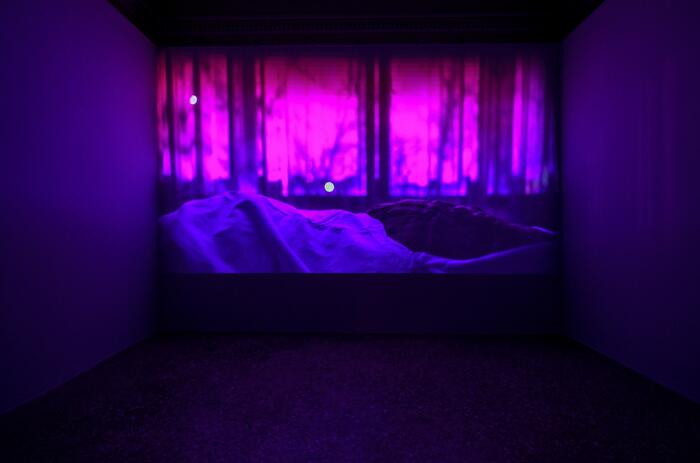
The Georgian Pavilion in the 60th Venice Biennale presented The Art of Seeing– States of Astronomy, a collaborative project presented by a team of Georgian and French curators and artists.
THE ART OF SEEING: GEORGIA’S PAVILION IN THE VENICE BIENNALE
The Georgian Pavilion in the 60th Venice Biennale presented The Art of Seeing– States of Astronomy, a collaborative project presented by a team of Georgian and French curators and artists.
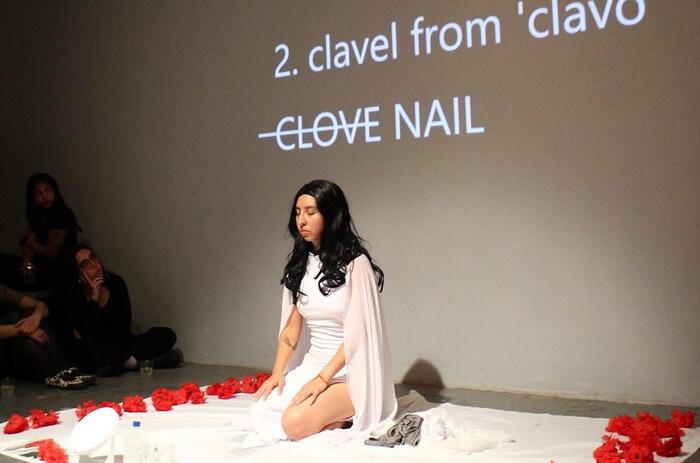
Argentina Performance Art, the first platform dedicated exclusively to the archive and theoretical research on Performance Art in Argentina, has opened a call for interns to join the team in the Internship Program 2024-2025.
OPEN CALL: INTERNSHIP PROGRAM IN ARGENTINA PERFORMANCE ART
Argentina Performance Art, the first platform dedicated exclusively to the archive and theoretical research on Performance Art in Argentina, has opened a call for interns to join the team in the Internship Program 2024-2025.

The Museo de Arte Moderno de Buenos Aires invites artists and art professionals from Argentina and abroad who have been living in the country for 3 years or more to apply to the Casa Alberto Heredia Residency Program. Applications will be accepted until June 30, 2024 for the periods August-December 2024 and March-June 2025.
OPEN CALL FOR ARTIST RESIDENCY PROGRAM AT CASA ALBERTO HEREDIA
The Museo de Arte Moderno de Buenos Aires invites artists and art professionals from Argentina and abroad who have been living in the country for 3 years or more to apply to the Casa Alberto Heredia Residency Program. Applications will be accepted until June 30, 2024 for the periods August-December 2024 and March-June 2025.

The exhibition at Rolf Art REVUELTAS by Gabriela Golder - one of Argentina's most internationally recognized audiovisual artists - presents video works in dialogue with the historic lithographic works of master printmaker Guillermo Facio Hebequer.
GABRIELA GOLDER: REVISITING THE WORKS OF FACIO HEBEQUER

The group exhibition Los gestos del trabajo (The Gestures of Work), curated by Clarisa Appendino and Benedetta Casini, at MUNTREF Centro de Arte Contemporáneo presents works that explore the relationship between bodies, technology and work.
THE GESTURES OF WORK
The group exhibition Los gestos del trabajo (The Gestures of Work), curated by Clarisa Appendino and Benedetta Casini, at MUNTREF Centro de Arte Contemporáneo presents works that explore the relationship between bodies, technology and work.

The curatorial team of the Toronto Biennial of Art (the Biennial/TBA) and its curatorial team of Dominique Fontaine and Miguel A. López announced the title, full artist list and venues for its third edition.
TORONTO BIENNIAL OF ART: PRECARIOUS JOYS
The curatorial team of the Toronto Biennial of Art (the Biennial/TBA) and its curatorial team of Dominique Fontaine and Miguel A. López announced the title, full artist list and venues for its third edition.

Patricio Reig (San Juan, Argentina, 1952) exhibits at the Centre Cultural La Mercè in Girona Anatomía de la mirada, a proposal that deals with the dissection of the act of looking and its individual and subjective approach.
PATRICIO REIG AND THE ANATOMY OF THE GAZE
Patricio Reig (San Juan, Argentina, 1952) exhibits at the Centre Cultural La Mercè in Girona Anatomía de la mirada, a proposal that deals with the dissection of the act of looking and its individual and subjective approach.

The heart of a giraffe in captivity is twelve kilos lighter tells the story of Lenka the giraffe, drawing on the history of Czechoslovakia’s acquisition of animals from the Global South. Interpreted through contemporary ecological and decolonial perspectives, Eva Kotátková’s project of the Czech and Slovak Republic Pavilion at the Venice Biennale builds a space for imagining a different way of relating to nature.
THE VENICE BIENNALE: CZECH AND SLOVAK REPUBLIC PAVILION
The heart of a giraffe in captivity is twelve kilos lighter tells the story of Lenka the giraffe, drawing on the history of Czechoslovakia’s acquisition of animals from the Global South. Interpreted through contemporary ecological and decolonial perspectives, Eva Kotátková’s project of the Czech and Slovak Republic Pavilion at the Venice Biennale builds a space for imagining a different way of relating to nature.

The Japan Foundation, the commissioner of the Japan Pavilion presents Compose, a solo exhibition created by Yuko Mohri and curated by Sook-Kyung Lee at the 60th International Venice Biennale.
COMPOSE: JAPAN PAVILION AT THE VENICE BIENNALE
The Japan Foundation, the commissioner of the Japan Pavilion presents Compose, a solo exhibition created by Yuko Mohri and curated by Sook-Kyung Lee at the 60th International Venice Biennale.

Commissioned by Facundo de Almeida and curated by Elisa Valerio, the national pavilion of Uruguay presents the work of Eduardo Cardozo with the project Latent.
THE PAVILION OF URUGUAY AT THE 60TH VENICE BIENNALE
Commissioned by Facundo de Almeida and curated by Elisa Valerio, the national pavilion of Uruguay presents the work of Eduardo Cardozo with the project Latent.

For the 60th Venice Biennale, the Republic of Armenia presents Echo, a multi-dimensional multi-media installation project by Paris-based Armenian artist Nina Khemchyan.
“ECHO” BY NINCA KHEMCHYAN: ARMENIAN PAVILION IN THE VENICE BIENNALE
For the 60th Venice Biennale, the Republic of Armenia presents Echo, a multi-dimensional multi-media installation project by Paris-based Armenian artist Nina Khemchyan.

The Seoul Museum of Art is announcing an open call for the position of artistic director of the 13th Seoul Mediacity Biennale. Deadline to apply: July 28th, 2024.
13th SEOUL MEDIACITY BIENNALE CALLS FOR ARTISTIC DIRECTOR
The Seoul Museum of Art is announcing an open call for the position of artistic director of the 13th Seoul Mediacity Biennale. Deadline to apply: July 28th, 2024.

The Venice Bienanale’s Swiss Pavilion presents Super Superior Civilizations: an exhibition with the sixth and seventh chapters of Guerreiro do Divino Amor’s monumental “Superfictional World Atlas” saga: The Miracle of Helvetia and Roma Talismano. Curated by: Andrea Bellini.
THE SWISS PAVILION’S VENICE BIENNALE EXHIBITION BY GUERREIRO DO DIVINO AMOR
The Venice Bienanale’s Swiss Pavilion presents Super Superior Civilizations: an exhibition with the sixth and seventh chapters of Guerreiro do Divino Amor’s monumental “Superfictional World Atlas” saga: The Miracle of Helvetia and Roma Talismano. Curated by: Andrea Bellini.

Maria Madeira is the artist representing Timor-Leste at the 60th International Venice Biennale. Timor-Leste’s inaugural pavilion coincides with the country’s 25th anniversary of independence. Commissioned by the Ministry of Youth, Sports, Arts and Culture, Democratic Republic of Timor-Leste and curated by Professor Natalie King OAM.
KISS AND DON’T TELL: TIMOR-LESTE IN THE VENICE BIENNALE
Maria Madeira is the artist representing Timor-Leste at the 60th International Venice Biennale. Timor-Leste’s inaugural pavilion coincides with the country’s 25th anniversary of independence. Commissioned by the Ministry of Youth, Sports, Arts and Culture, Democratic Republic of Timor-Leste and curated by Professor Natalie King OAM.

Due qui / To Hear is the project for the Italian Pavilion at the 60th Venice Biennale Curated by Luca Cerizza (with the assistance of Francesca Verga), it presents work that Massimo Bartolini has created in collaboration with several musicians (for the permanent installations) and writers (for the public program), employing the cooperative approach that is a hallmark of his practice.
DUE QUI/TO HEAR: ITALY’S PAVILION FOR THE VENICE BIENNALE
Due qui / To Hear is the project for the Italian Pavilion at the 60th Venice Biennale Curated by Luca Cerizza (with the assistance of Francesca Verga), it presents work that Massimo Bartolini has created in collaboration with several musicians (for the permanent installations) and writers (for the public program), employing the cooperative approach that is a hallmark of his practice.

The Georgian Pavilion in the 60th Venice Biennale presented The Art of Seeing– States of Astronomy, a collaborative project presented by a team of Georgian and French curators and artists.
THE ART OF SEEING: GEORGIA’S PAVILION IN THE VENICE BIENNALE
The Georgian Pavilion in the 60th Venice Biennale presented The Art of Seeing– States of Astronomy, a collaborative project presented by a team of Georgian and French curators and artists.

Argentina Performance Art, the first platform dedicated exclusively to the archive and theoretical research on Performance Art in Argentina, has opened a call for interns to join the team in the Internship Program 2024-2025.
OPEN CALL: INTERNSHIP PROGRAM IN ARGENTINA PERFORMANCE ART
Argentina Performance Art, the first platform dedicated exclusively to the archive and theoretical research on Performance Art in Argentina, has opened a call for interns to join the team in the Internship Program 2024-2025.

The Museo de Arte Moderno de Buenos Aires invites artists and art professionals from Argentina and abroad who have been living in the country for 3 years or more to apply to the Casa Alberto Heredia Residency Program. Applications will be accepted until June 30, 2024 for the periods August-December 2024 and March-June 2025.
OPEN CALL FOR ARTIST RESIDENCY PROGRAM AT CASA ALBERTO HEREDIA
The Museo de Arte Moderno de Buenos Aires invites artists and art professionals from Argentina and abroad who have been living in the country for 3 years or more to apply to the Casa Alberto Heredia Residency Program. Applications will be accepted until June 30, 2024 for the periods August-December 2024 and March-June 2025.

The exhibition at Rolf Art REVUELTAS by Gabriela Golder - one of Argentina's most internationally recognized audiovisual artists - presents video works in dialogue with the historic lithographic works of master printmaker Guillermo Facio Hebequer.
GABRIELA GOLDER: REVISITING THE WORKS OF FACIO HEBEQUER

The group exhibition Los gestos del trabajo (The Gestures of Work), curated by Clarisa Appendino and Benedetta Casini, at MUNTREF Centro de Arte Contemporáneo presents works that explore the relationship between bodies, technology and work.
THE GESTURES OF WORK
The group exhibition Los gestos del trabajo (The Gestures of Work), curated by Clarisa Appendino and Benedetta Casini, at MUNTREF Centro de Arte Contemporáneo presents works that explore the relationship between bodies, technology and work.

The curatorial team of the Toronto Biennial of Art (the Biennial/TBA) and its curatorial team of Dominique Fontaine and Miguel A. López announced the title, full artist list and venues for its third edition.
TORONTO BIENNIAL OF ART: PRECARIOUS JOYS
The curatorial team of the Toronto Biennial of Art (the Biennial/TBA) and its curatorial team of Dominique Fontaine and Miguel A. López announced the title, full artist list and venues for its third edition.

Patricio Reig (San Juan, Argentina, 1952) exhibits at the Centre Cultural La Mercè in Girona Anatomía de la mirada, a proposal that deals with the dissection of the act of looking and its individual and subjective approach.
PATRICIO REIG AND THE ANATOMY OF THE GAZE
Patricio Reig (San Juan, Argentina, 1952) exhibits at the Centre Cultural La Mercè in Girona Anatomía de la mirada, a proposal that deals with the dissection of the act of looking and its individual and subjective approach.

The heart of a giraffe in captivity is twelve kilos lighter tells the story of Lenka the giraffe, drawing on the history of Czechoslovakia’s acquisition of animals from the Global South. Interpreted through contemporary ecological and decolonial perspectives, Eva Kotátková’s project of the Czech and Slovak Republic Pavilion at the Venice Biennale builds a space for imagining a different way of relating to nature.
THE VENICE BIENNALE: CZECH AND SLOVAK REPUBLIC PAVILION
The heart of a giraffe in captivity is twelve kilos lighter tells the story of Lenka the giraffe, drawing on the history of Czechoslovakia’s acquisition of animals from the Global South. Interpreted through contemporary ecological and decolonial perspectives, Eva Kotátková’s project of the Czech and Slovak Republic Pavilion at the Venice Biennale builds a space for imagining a different way of relating to nature.

The Japan Foundation, the commissioner of the Japan Pavilion presents Compose, a solo exhibition created by Yuko Mohri and curated by Sook-Kyung Lee at the 60th International Venice Biennale.
COMPOSE: JAPAN PAVILION AT THE VENICE BIENNALE
The Japan Foundation, the commissioner of the Japan Pavilion presents Compose, a solo exhibition created by Yuko Mohri and curated by Sook-Kyung Lee at the 60th International Venice Biennale.

Commissioned by Facundo de Almeida and curated by Elisa Valerio, the national pavilion of Uruguay presents the work of Eduardo Cardozo with the project Latent.
THE PAVILION OF URUGUAY AT THE 60TH VENICE BIENNALE
Commissioned by Facundo de Almeida and curated by Elisa Valerio, the national pavilion of Uruguay presents the work of Eduardo Cardozo with the project Latent.

For the 60th Venice Biennale, the Republic of Armenia presents Echo, a multi-dimensional multi-media installation project by Paris-based Armenian artist Nina Khemchyan.
“ECHO” BY NINCA KHEMCHYAN: ARMENIAN PAVILION IN THE VENICE BIENNALE
For the 60th Venice Biennale, the Republic of Armenia presents Echo, a multi-dimensional multi-media installation project by Paris-based Armenian artist Nina Khemchyan.

The Seoul Museum of Art is announcing an open call for the position of artistic director of the 13th Seoul Mediacity Biennale. Deadline to apply: July 28th, 2024.
13th SEOUL MEDIACITY BIENNALE CALLS FOR ARTISTIC DIRECTOR
The Seoul Museum of Art is announcing an open call for the position of artistic director of the 13th Seoul Mediacity Biennale. Deadline to apply: July 28th, 2024.

The Venice Bienanale’s Swiss Pavilion presents Super Superior Civilizations: an exhibition with the sixth and seventh chapters of Guerreiro do Divino Amor’s monumental “Superfictional World Atlas” saga: The Miracle of Helvetia and Roma Talismano. Curated by: Andrea Bellini.
THE SWISS PAVILION’S VENICE BIENNALE EXHIBITION BY GUERREIRO DO DIVINO AMOR
The Venice Bienanale’s Swiss Pavilion presents Super Superior Civilizations: an exhibition with the sixth and seventh chapters of Guerreiro do Divino Amor’s monumental “Superfictional World Atlas” saga: The Miracle of Helvetia and Roma Talismano. Curated by: Andrea Bellini.

Maria Madeira is the artist representing Timor-Leste at the 60th International Venice Biennale. Timor-Leste’s inaugural pavilion coincides with the country’s 25th anniversary of independence. Commissioned by the Ministry of Youth, Sports, Arts and Culture, Democratic Republic of Timor-Leste and curated by Professor Natalie King OAM.
KISS AND DON’T TELL: TIMOR-LESTE IN THE VENICE BIENNALE
Maria Madeira is the artist representing Timor-Leste at the 60th International Venice Biennale. Timor-Leste’s inaugural pavilion coincides with the country’s 25th anniversary of independence. Commissioned by the Ministry of Youth, Sports, Arts and Culture, Democratic Republic of Timor-Leste and curated by Professor Natalie King OAM.

Due qui / To Hear is the project for the Italian Pavilion at the 60th Venice Biennale Curated by Luca Cerizza (with the assistance of Francesca Verga), it presents work that Massimo Bartolini has created in collaboration with several musicians (for the permanent installations) and writers (for the public program), employing the cooperative approach that is a hallmark of his practice.
DUE QUI/TO HEAR: ITALY’S PAVILION FOR THE VENICE BIENNALE
Due qui / To Hear is the project for the Italian Pavilion at the 60th Venice Biennale Curated by Luca Cerizza (with the assistance of Francesca Verga), it presents work that Massimo Bartolini has created in collaboration with several musicians (for the permanent installations) and writers (for the public program), employing the cooperative approach that is a hallmark of his practice.

The Georgian Pavilion in the 60th Venice Biennale presented The Art of Seeing– States of Astronomy, a collaborative project presented by a team of Georgian and French curators and artists.
THE ART OF SEEING: GEORGIA’S PAVILION IN THE VENICE BIENNALE
The Georgian Pavilion in the 60th Venice Biennale presented The Art of Seeing– States of Astronomy, a collaborative project presented by a team of Georgian and French curators and artists.

Argentina Performance Art, the first platform dedicated exclusively to the archive and theoretical research on Performance Art in Argentina, has opened a call for interns to join the team in the Internship Program 2024-2025.
OPEN CALL: INTERNSHIP PROGRAM IN ARGENTINA PERFORMANCE ART
Argentina Performance Art, the first platform dedicated exclusively to the archive and theoretical research on Performance Art in Argentina, has opened a call for interns to join the team in the Internship Program 2024-2025.

The Museo de Arte Moderno de Buenos Aires invites artists and art professionals from Argentina and abroad who have been living in the country for 3 years or more to apply to the Casa Alberto Heredia Residency Program. Applications will be accepted until June 30, 2024 for the periods August-December 2024 and March-June 2025.
OPEN CALL FOR ARTIST RESIDENCY PROGRAM AT CASA ALBERTO HEREDIA
The Museo de Arte Moderno de Buenos Aires invites artists and art professionals from Argentina and abroad who have been living in the country for 3 years or more to apply to the Casa Alberto Heredia Residency Program. Applications will be accepted until June 30, 2024 for the periods August-December 2024 and March-June 2025.

The exhibition at Rolf Art REVUELTAS by Gabriela Golder - one of Argentina's most internationally recognized audiovisual artists - presents video works in dialogue with the historic lithographic works of master printmaker Guillermo Facio Hebequer.
GABRIELA GOLDER: REVISITING THE WORKS OF FACIO HEBEQUER

The group exhibition Los gestos del trabajo (The Gestures of Work), curated by Clarisa Appendino and Benedetta Casini, at MUNTREF Centro de Arte Contemporáneo presents works that explore the relationship between bodies, technology and work.
THE GESTURES OF WORK
The group exhibition Los gestos del trabajo (The Gestures of Work), curated by Clarisa Appendino and Benedetta Casini, at MUNTREF Centro de Arte Contemporáneo presents works that explore the relationship between bodies, technology and work.

The curatorial team of the Toronto Biennial of Art (the Biennial/TBA) and its curatorial team of Dominique Fontaine and Miguel A. López announced the title, full artist list and venues for its third edition.
TORONTO BIENNIAL OF ART: PRECARIOUS JOYS
The curatorial team of the Toronto Biennial of Art (the Biennial/TBA) and its curatorial team of Dominique Fontaine and Miguel A. López announced the title, full artist list and venues for its third edition.

Patricio Reig (San Juan, Argentina, 1952) exhibits at the Centre Cultural La Mercè in Girona Anatomía de la mirada, a proposal that deals with the dissection of the act of looking and its individual and subjective approach.
PATRICIO REIG AND THE ANATOMY OF THE GAZE
Patricio Reig (San Juan, Argentina, 1952) exhibits at the Centre Cultural La Mercè in Girona Anatomía de la mirada, a proposal that deals with the dissection of the act of looking and its individual and subjective approach.

The heart of a giraffe in captivity is twelve kilos lighter tells the story of Lenka the giraffe, drawing on the history of Czechoslovakia’s acquisition of animals from the Global South. Interpreted through contemporary ecological and decolonial perspectives, Eva Kotátková’s project of the Czech and Slovak Republic Pavilion at the Venice Biennale builds a space for imagining a different way of relating to nature.
THE VENICE BIENNALE: CZECH AND SLOVAK REPUBLIC PAVILION
The heart of a giraffe in captivity is twelve kilos lighter tells the story of Lenka the giraffe, drawing on the history of Czechoslovakia’s acquisition of animals from the Global South. Interpreted through contemporary ecological and decolonial perspectives, Eva Kotátková’s project of the Czech and Slovak Republic Pavilion at the Venice Biennale builds a space for imagining a different way of relating to nature.

The Japan Foundation, the commissioner of the Japan Pavilion presents Compose, a solo exhibition created by Yuko Mohri and curated by Sook-Kyung Lee at the 60th International Venice Biennale.
COMPOSE: JAPAN PAVILION AT THE VENICE BIENNALE
The Japan Foundation, the commissioner of the Japan Pavilion presents Compose, a solo exhibition created by Yuko Mohri and curated by Sook-Kyung Lee at the 60th International Venice Biennale.

Commissioned by Facundo de Almeida and curated by Elisa Valerio, the national pavilion of Uruguay presents the work of Eduardo Cardozo with the project Latent.
THE PAVILION OF URUGUAY AT THE 60TH VENICE BIENNALE
Commissioned by Facundo de Almeida and curated by Elisa Valerio, the national pavilion of Uruguay presents the work of Eduardo Cardozo with the project Latent.

For the 60th Venice Biennale, the Republic of Armenia presents Echo, a multi-dimensional multi-media installation project by Paris-based Armenian artist Nina Khemchyan.
“ECHO” BY NINCA KHEMCHYAN: ARMENIAN PAVILION IN THE VENICE BIENNALE
For the 60th Venice Biennale, the Republic of Armenia presents Echo, a multi-dimensional multi-media installation project by Paris-based Armenian artist Nina Khemchyan.

The Seoul Museum of Art is announcing an open call for the position of artistic director of the 13th Seoul Mediacity Biennale. Deadline to apply: July 28th, 2024.
13th SEOUL MEDIACITY BIENNALE CALLS FOR ARTISTIC DIRECTOR
The Seoul Museum of Art is announcing an open call for the position of artistic director of the 13th Seoul Mediacity Biennale. Deadline to apply: July 28th, 2024.

The Venice Bienanale’s Swiss Pavilion presents Super Superior Civilizations: an exhibition with the sixth and seventh chapters of Guerreiro do Divino Amor’s monumental “Superfictional World Atlas” saga: The Miracle of Helvetia and Roma Talismano. Curated by: Andrea Bellini.
THE SWISS PAVILION’S VENICE BIENNALE EXHIBITION BY GUERREIRO DO DIVINO AMOR
The Venice Bienanale’s Swiss Pavilion presents Super Superior Civilizations: an exhibition with the sixth and seventh chapters of Guerreiro do Divino Amor’s monumental “Superfictional World Atlas” saga: The Miracle of Helvetia and Roma Talismano. Curated by: Andrea Bellini.

Maria Madeira is the artist representing Timor-Leste at the 60th International Venice Biennale. Timor-Leste’s inaugural pavilion coincides with the country’s 25th anniversary of independence. Commissioned by the Ministry of Youth, Sports, Arts and Culture, Democratic Republic of Timor-Leste and curated by Professor Natalie King OAM.
KISS AND DON’T TELL: TIMOR-LESTE IN THE VENICE BIENNALE
Maria Madeira is the artist representing Timor-Leste at the 60th International Venice Biennale. Timor-Leste’s inaugural pavilion coincides with the country’s 25th anniversary of independence. Commissioned by the Ministry of Youth, Sports, Arts and Culture, Democratic Republic of Timor-Leste and curated by Professor Natalie King OAM.

Due qui / To Hear is the project for the Italian Pavilion at the 60th Venice Biennale Curated by Luca Cerizza (with the assistance of Francesca Verga), it presents work that Massimo Bartolini has created in collaboration with several musicians (for the permanent installations) and writers (for the public program), employing the cooperative approach that is a hallmark of his practice.
DUE QUI/TO HEAR: ITALY’S PAVILION FOR THE VENICE BIENNALE
Due qui / To Hear is the project for the Italian Pavilion at the 60th Venice Biennale Curated by Luca Cerizza (with the assistance of Francesca Verga), it presents work that Massimo Bartolini has created in collaboration with several musicians (for the permanent installations) and writers (for the public program), employing the cooperative approach that is a hallmark of his practice.

The Georgian Pavilion in the 60th Venice Biennale presented The Art of Seeing– States of Astronomy, a collaborative project presented by a team of Georgian and French curators and artists.
THE ART OF SEEING: GEORGIA’S PAVILION IN THE VENICE BIENNALE
The Georgian Pavilion in the 60th Venice Biennale presented The Art of Seeing– States of Astronomy, a collaborative project presented by a team of Georgian and French curators and artists.

Argentina Performance Art, the first platform dedicated exclusively to the archive and theoretical research on Performance Art in Argentina, has opened a call for interns to join the team in the Internship Program 2024-2025.
OPEN CALL: INTERNSHIP PROGRAM IN ARGENTINA PERFORMANCE ART
Argentina Performance Art, the first platform dedicated exclusively to the archive and theoretical research on Performance Art in Argentina, has opened a call for interns to join the team in the Internship Program 2024-2025.

The Museo de Arte Moderno de Buenos Aires invites artists and art professionals from Argentina and abroad who have been living in the country for 3 years or more to apply to the Casa Alberto Heredia Residency Program. Applications will be accepted until June 30, 2024 for the periods August-December 2024 and March-June 2025.
OPEN CALL FOR ARTIST RESIDENCY PROGRAM AT CASA ALBERTO HEREDIA
The Museo de Arte Moderno de Buenos Aires invites artists and art professionals from Argentina and abroad who have been living in the country for 3 years or more to apply to the Casa Alberto Heredia Residency Program. Applications will be accepted until June 30, 2024 for the periods August-December 2024 and March-June 2025.

The exhibition at Rolf Art REVUELTAS by Gabriela Golder - one of Argentina's most internationally recognized audiovisual artists - presents video works in dialogue with the historic lithographic works of master printmaker Guillermo Facio Hebequer.
GABRIELA GOLDER: REVISITING THE WORKS OF FACIO HEBEQUER

The group exhibition Los gestos del trabajo (The Gestures of Work), curated by Clarisa Appendino and Benedetta Casini, at MUNTREF Centro de Arte Contemporáneo presents works that explore the relationship between bodies, technology and work.
THE GESTURES OF WORK
The group exhibition Los gestos del trabajo (The Gestures of Work), curated by Clarisa Appendino and Benedetta Casini, at MUNTREF Centro de Arte Contemporáneo presents works that explore the relationship between bodies, technology and work.

The curatorial team of the Toronto Biennial of Art (the Biennial/TBA) and its curatorial team of Dominique Fontaine and Miguel A. López announced the title, full artist list and venues for its third edition.
TORONTO BIENNIAL OF ART: PRECARIOUS JOYS
The curatorial team of the Toronto Biennial of Art (the Biennial/TBA) and its curatorial team of Dominique Fontaine and Miguel A. López announced the title, full artist list and venues for its third edition.

Patricio Reig (San Juan, Argentina, 1952) exhibits at the Centre Cultural La Mercè in Girona Anatomía de la mirada, a proposal that deals with the dissection of the act of looking and its individual and subjective approach.
PATRICIO REIG AND THE ANATOMY OF THE GAZE
Patricio Reig (San Juan, Argentina, 1952) exhibits at the Centre Cultural La Mercè in Girona Anatomía de la mirada, a proposal that deals with the dissection of the act of looking and its individual and subjective approach.

The heart of a giraffe in captivity is twelve kilos lighter tells the story of Lenka the giraffe, drawing on the history of Czechoslovakia’s acquisition of animals from the Global South. Interpreted through contemporary ecological and decolonial perspectives, Eva Kotátková’s project of the Czech and Slovak Republic Pavilion at the Venice Biennale builds a space for imagining a different way of relating to nature.
THE VENICE BIENNALE: CZECH AND SLOVAK REPUBLIC PAVILION
The heart of a giraffe in captivity is twelve kilos lighter tells the story of Lenka the giraffe, drawing on the history of Czechoslovakia’s acquisition of animals from the Global South. Interpreted through contemporary ecological and decolonial perspectives, Eva Kotátková’s project of the Czech and Slovak Republic Pavilion at the Venice Biennale builds a space for imagining a different way of relating to nature.

The Japan Foundation, the commissioner of the Japan Pavilion presents Compose, a solo exhibition created by Yuko Mohri and curated by Sook-Kyung Lee at the 60th International Venice Biennale.
COMPOSE: JAPAN PAVILION AT THE VENICE BIENNALE
The Japan Foundation, the commissioner of the Japan Pavilion presents Compose, a solo exhibition created by Yuko Mohri and curated by Sook-Kyung Lee at the 60th International Venice Biennale.

Commissioned by Facundo de Almeida and curated by Elisa Valerio, the national pavilion of Uruguay presents the work of Eduardo Cardozo with the project Latent.
THE PAVILION OF URUGUAY AT THE 60TH VENICE BIENNALE
Commissioned by Facundo de Almeida and curated by Elisa Valerio, the national pavilion of Uruguay presents the work of Eduardo Cardozo with the project Latent.

For the 60th Venice Biennale, the Republic of Armenia presents Echo, a multi-dimensional multi-media installation project by Paris-based Armenian artist Nina Khemchyan.
“ECHO” BY NINCA KHEMCHYAN: ARMENIAN PAVILION IN THE VENICE BIENNALE
For the 60th Venice Biennale, the Republic of Armenia presents Echo, a multi-dimensional multi-media installation project by Paris-based Armenian artist Nina Khemchyan.

The Seoul Museum of Art is announcing an open call for the position of artistic director of the 13th Seoul Mediacity Biennale. Deadline to apply: July 28th, 2024.
13th SEOUL MEDIACITY BIENNALE CALLS FOR ARTISTIC DIRECTOR
The Seoul Museum of Art is announcing an open call for the position of artistic director of the 13th Seoul Mediacity Biennale. Deadline to apply: July 28th, 2024.

The Venice Bienanale’s Swiss Pavilion presents Super Superior Civilizations: an exhibition with the sixth and seventh chapters of Guerreiro do Divino Amor’s monumental “Superfictional World Atlas” saga: The Miracle of Helvetia and Roma Talismano. Curated by: Andrea Bellini.
THE SWISS PAVILION’S VENICE BIENNALE EXHIBITION BY GUERREIRO DO DIVINO AMOR
The Venice Bienanale’s Swiss Pavilion presents Super Superior Civilizations: an exhibition with the sixth and seventh chapters of Guerreiro do Divino Amor’s monumental “Superfictional World Atlas” saga: The Miracle of Helvetia and Roma Talismano. Curated by: Andrea Bellini.

Maria Madeira is the artist representing Timor-Leste at the 60th International Venice Biennale. Timor-Leste’s inaugural pavilion coincides with the country’s 25th anniversary of independence. Commissioned by the Ministry of Youth, Sports, Arts and Culture, Democratic Republic of Timor-Leste and curated by Professor Natalie King OAM.
KISS AND DON’T TELL: TIMOR-LESTE IN THE VENICE BIENNALE
Maria Madeira is the artist representing Timor-Leste at the 60th International Venice Biennale. Timor-Leste’s inaugural pavilion coincides with the country’s 25th anniversary of independence. Commissioned by the Ministry of Youth, Sports, Arts and Culture, Democratic Republic of Timor-Leste and curated by Professor Natalie King OAM.

Due qui / To Hear is the project for the Italian Pavilion at the 60th Venice Biennale Curated by Luca Cerizza (with the assistance of Francesca Verga), it presents work that Massimo Bartolini has created in collaboration with several musicians (for the permanent installations) and writers (for the public program), employing the cooperative approach that is a hallmark of his practice.
DUE QUI/TO HEAR: ITALY’S PAVILION FOR THE VENICE BIENNALE
Due qui / To Hear is the project for the Italian Pavilion at the 60th Venice Biennale Curated by Luca Cerizza (with the assistance of Francesca Verga), it presents work that Massimo Bartolini has created in collaboration with several musicians (for the permanent installations) and writers (for the public program), employing the cooperative approach that is a hallmark of his practice.

The Georgian Pavilion in the 60th Venice Biennale presented The Art of Seeing– States of Astronomy, a collaborative project presented by a team of Georgian and French curators and artists.
THE ART OF SEEING: GEORGIA’S PAVILION IN THE VENICE BIENNALE
The Georgian Pavilion in the 60th Venice Biennale presented The Art of Seeing– States of Astronomy, a collaborative project presented by a team of Georgian and French curators and artists.

Argentina Performance Art, the first platform dedicated exclusively to the archive and theoretical research on Performance Art in Argentina, has opened a call for interns to join the team in the Internship Program 2024-2025.
OPEN CALL: INTERNSHIP PROGRAM IN ARGENTINA PERFORMANCE ART
Argentina Performance Art, the first platform dedicated exclusively to the archive and theoretical research on Performance Art in Argentina, has opened a call for interns to join the team in the Internship Program 2024-2025.

The Museo de Arte Moderno de Buenos Aires invites artists and art professionals from Argentina and abroad who have been living in the country for 3 years or more to apply to the Casa Alberto Heredia Residency Program. Applications will be accepted until June 30, 2024 for the periods August-December 2024 and March-June 2025.
OPEN CALL FOR ARTIST RESIDENCY PROGRAM AT CASA ALBERTO HEREDIA
The Museo de Arte Moderno de Buenos Aires invites artists and art professionals from Argentina and abroad who have been living in the country for 3 years or more to apply to the Casa Alberto Heredia Residency Program. Applications will be accepted until June 30, 2024 for the periods August-December 2024 and March-June 2025.




